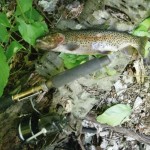Bonneville Cutthroat Trout, Oncorhynchus clarki utah
by Dan Potts, Spring 2014

The California rainbow trout was our state fish for many decades.
Some may be familiar with this year’s effort by local grade school students to change our state tree from the Colorado blue spruce to our own quaking aspen through the Utah Legislature.
Years ago a group of 1st graders also approached the Legislature with a similar recommendation to change that state fish to one of our own native fish, the Utah (Bonneville) cutthroat trout – it passed, just like the current tree proposal!
Most residents in the Salt Lake Valley probably think that our native cutthroat can only be found in higher elevation trout streams.
Our state fish is, however, a truly a tough species, very capable of surviving most of the year in the Jordan River, Utah Lake, and in other warmer, lowland waters.
Typically, Bonnevilles enter the Jordan from one of its various tributary streams draining the Wasatch Mountains, including City Creek, Red Butte Creek, Mill Creek, and both Cottonwood creeks, where they and other trout can occasionally be seen in their sometimes clearer waters, especially near the inlets.
Poor water quality and higher summertime temperatures do drive these trout back into these tributary streams, or to the cooler waters nearer the mouths of their inlets.
Bonneville “cuts” are considered to be true trout, as they possess dark spots on a lighter background, like rainbow and brown trout.
But unlike these other trout these spots are mostly concentrated towards the rear of their body, making identification (even in the water) easier.
Many local fisheries biologists consider the Bonneville superior to the rainbow trout as a sport fish, because it is capable of surviving in waters too warm for rainbows, and because they are willing to eat a wider variety of available foods, and are therefore easier to catch on hook and line.
Although anglers fishing the Jordan River usually do not consume their catch due to the many pollutants and off-flavor compounds found in the river in the more urbanized areas near humans, fish farther upstream towards the Narrows are considered safer and taste better.
Regardless, they can provide pretty good sport fishing in and around the tributary inlets, and create a topic for conversation if caught.
I always recommend that they be safely released alive, although a quick photo is cool.
Bonneville cutthroat trout are never very numerous in the Jordan River, but I am always amazed that they are able to out-survive even introduced, exotic brown trout also found in some of our lowland waters here in Utah.

